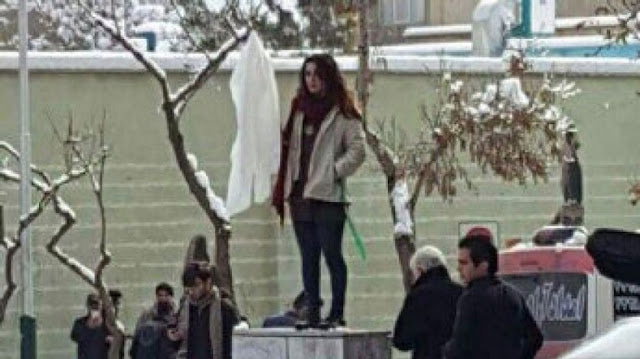IRAN ARRESTS 29 WOMEN FOR NOT WEARING HIJAB IN PROTESTS
 |
| Vida Movahed, 31, was arrested after taking off her hijab in public and standing on a telecoms box in Tehran in December. |
Tasnim news agency reported on Friday
that 29 women had been arrested, and quoted Tehran police as saying that the
detainees were arrested for "disturbing public security".
It was unclear where else arrests had
been made, as protests have spread from the capital to other areas, including
the ancient cities of Esfahan and Shiraz.
The mandatory headscarf, or hijab, has
been in place in Iran since 1979, after the Iranian revolution and the
installation of Ayatollah Khomeini as Supreme Leader.
Over the years, hundreds of thousands
of Iranian women have protested against the law.
Two friends, one against the hijab, the other for, have sent their pix to @RadioFarda_ from Yasouj in southwestern Iran to express support for women protesting compulsory hijab #دختران_خیابان_انقلاب pic.twitter.com/FlRwYNyAJS— Golnaz Esfandiari (@GEsfandiari) February 1, 2018
In recent weeks, following a new wave
of protests in the country, women renewed their opposition to the law, taking
off their hijabs in public and waving them on wooden sticks like flags.
Holly Dagres, an Iranian-American
analyst, said Iranian authorities are "very much aware" that more
than half of the population is against wearing the hijab.
"It's evident by the fact that
the morality police are on constant patrol of the streets of major cities like
Tehran," Dagres told Al Jazeera.
"Authorities know that if they
don't crack down, Iranian women will continue to test the boundaries of what
they can and cannot wear."
Dagres said that more arrests were
likely to spur solidarity with the campaign.
On social media on
Friday, Masih Alinejad, an exiled Iranian activist who started the campaign
against the compulsory hijab, singled out Iranian Foreign Minister Javad Zarif
for "remaining silent" on the arrests.
'SMALL ACTS OF RESISTANCE'
While hijab protests
are not new, Dagres told Al Jazeera that recent rallies were inspired by a lone
female demonstrator, who stood on a busy pavement in central Tehran waving her
white headscarf on a wooden stick.
The image of the
woman spread on social media.
Her case attracted
more attention when she was reportedly detained by police in late January. She
was later released on bail, according to the Iran Human Rights group.
In another viral
video, an elderly woman was shown struggling to walk in a snow-covered park,
then clambering up an idle fountain to wave her white scarf in the air.
Iran Human Rights
said that another woman, who also protested, had been transferred to a prison
south of Tehran, and that she is being held on bail set at $135,000.
On Wednesday,
Mohammad Jafar Montazeri, Iran's chief prosecutor, had denounced the protests
as "childish", suggesting that individuals from outside Iran are
inciting the movement.
Under Iran's law, a
woman who does not wear a hijab in public could face jail time or fines.
While only a few of
Iran's more than 80 million people have joined in the headscarf protest, social
media applications such as Telegram and Instagram have helped spread the news
quickly.
Some
hijab-supporting Iranian women back the protests.
One Iranian woman,
wearing the traditional black outer garment, or chador, was seen standing on
top of a utility box in the corner of a busy Iranian street expressing solidarity.
Omid Memarian, a
US-based Iranian journalist who was once imprisoned in Iran, wrote on social
media that the fight against forced hijab "is not about whether the hijab
is good or bad. It's about choice and equality. It's about dignity".
So far, the protest
still lacks momentum for Iran's authorities to consider amending the hijab law,
said Dagres.
"At the same
time, movements always start as small acts of resistance. If these protests
gain traction, we might see a shift," she said.
She added that when
it comes to women's rights in Iran, amendments to the marriage and divorce laws
need greater attention.













No comments